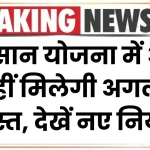
Looking for a safe and reliable way to grow your money? Fixed Deposits (FDs) from top Indian banks like SBI and HDFC Bank are offering attractive interest rates of up to 8% per annum, but there’s a catch — these special FD schemes are only available till March 31, 2025. If you’re planning to invest, now is the time to act.
Banks periodically introduce limited-time FD offers with higher-than-usual interest rates to attract depositors. These special schemes come with fixed tenures and offer better returns, especially for senior citizens. With the financial year ending, many investors are rushing to lock in their money and take advantage of these high-interest FDs.
Fixed Deposits: Interest on FDs of These Banks
| Feature | Details |
|---|---|
| Scheme Deadline | March 31, 2025 |
| Top Banks Offering | SBI, HDFC Bank, ICICI Bank, Axis Bank |
| Highest Interest Rate (General Citizens) | Up to 7.85% per annum |
| Highest Interest Rate (Senior Citizens) | Up to 8.35% per annum |
| SBI Amrit Kalash | 400 days @ 7.10% (Gen) / 7.60% (Sr) |
| SBI Amrit Vrishti | 444 days @ 7.25% (Gen) / 7.75% (Sr) |
| HDFC Special FD | 35 months @ 7.35% (Gen) / 7.85% (Sr) |
If you’re someone who values safe, guaranteed returns, the current FD offers from SBI, HDFC, and others are too good to ignore. These limited-time interest rates — some nearing 8% — make this the perfect time to invest before March 31, 2025. Act now and grow your money smartly.
What Is a Fixed Deposit and Why Is It Popular?
A Fixed Deposit (FD) is a type of investment where you deposit a lump sum with a bank for a fixed tenure. In return, the bank pays you interest over that period. It’s one of the safest and most popular investment options in India.
FDs are ideal for people who:
- Want a guaranteed return
- Prefer low-risk investments
- Are looking for regular income, especially retirees
Let’s explore the latest FD schemes and how you can take advantage before March 31.
see also: Post Office Scheme: You Will Get Interest of Lakhs on Monthly Investment of Rs. 900
SBI Special FD Schemes Ending March 31
1. SBI Amrit Kalash FD
- Tenure: 400 days
- Interest Rates:
- General Citizens: 7.10% per annum
- Senior Citizens: 7.60% per annum
- Eligibility: Available for domestic residents, NRE/NRO customers excluded
- Interest Payout: Can be monthly, quarterly, or cumulative
2. SBI Amrit Vrishti FD
- Tenure: 444 days
- Interest Rates:
- General Citizens: 7.25% per annum
- Senior Citizens: 7.75% per annum
You can open these deposits online via YONO SBI or by visiting your nearest SBI branch. More details are available on the official SBI site.
HDFC Bank’s Special FD Scheme
HDFC Bank has also introduced a Special Edition FD scheme with a higher interest rate, especially for longer tenure.
- Tenure: 35 months
- Interest Rates:
- General Citizens: 7.35% per annum
- Senior Citizens: 7.85% per annum
This is a limited period offer and can be booked online via HDFC NetBanking or at your branch.
Other Banks Also Offering Special FDs
ICICI Bank Golden Years FD (for Seniors Only)
- Tenure: 5 years and 1 day to 10 years
- Interest Rate: 7.65% per annum
Axis Bank Special FD
- Tenure: 400 days
- Interest Rate:
- General Citizens: 7.10%
- Senior Citizens: 7.85%
These offers are also available till March 31, so check with your bank for the latest applicable rates.
Why You Should Invest Before March 31
There are three strong reasons:
- High Interest Rates: These special schemes are offering up to 8.35% for seniors.
- End of Financial Year: Investing before March 31 can help you save tax under Section 80C of the Income Tax Act (up to ₹1.5 lakh).
- Safe Returns: FDs are insured up to ₹5 lakh under DICGC protection.
How to Open These FDs
Step 1: Choose Your Bank
Decide whether you want to invest in SBI, HDFC, ICICI, Axis, or any other bank offering special rates.
Step 2: Select the Scheme
Pick a scheme based on your financial goal and preferred tenure.
Step 3: Decide the Investment Amount
Make sure it fits within your budget and tax planning goals.
Step 4: Open Online or Visit the Branch
Most banks allow FD booking through net banking or mobile apps. Alternatively, visit a nearby branch.
Step 5: Submit KYC and PAN
You’ll need Aadhaar, PAN, and address proof for new accounts.
Expert Tips to Maximize Your FD Investment
- Ladder Your FDs: Invest in multiple FDs with different maturities to maintain liquidity.
- Prefer Senior Citizen FDs: If you or a family member is above 60, use their account to earn extra interest.
- Check Compounding Options: Cumulative FDs give better returns as the interest is reinvested.
- Compare Banks: Always check at least 3-4 bank rates before locking in your money.
see also: Start Investing from ₹100 and Get High Returns
Fixed Deposits: Interest on FDs of These Banks FAQs
Q1. Can I withdraw my FD before maturity?
Yes, but banks may charge a penalty of 0.5% to 1% on the interest rate.
Q2. Are FD returns taxable?
Yes, interest earned is fully taxable under “Income from Other Sources”. Banks also deduct TDS if interest exceeds ₹50,000/year for general citizens and ₹50,000/year for seniors.
Q3. Can NRIs invest in these special FD schemes?
Not all — for example, SBI’s Amrit Vrishti is not available to NRI customers.
Q4. What happens if I miss the March 31 deadline?
You can still invest in regular FDs, but you may miss out on special higher rates.
Q5. Is it better than mutual funds?
FDs are low-risk and stable, whereas mutual funds offer market-linked returns and higher risk.











